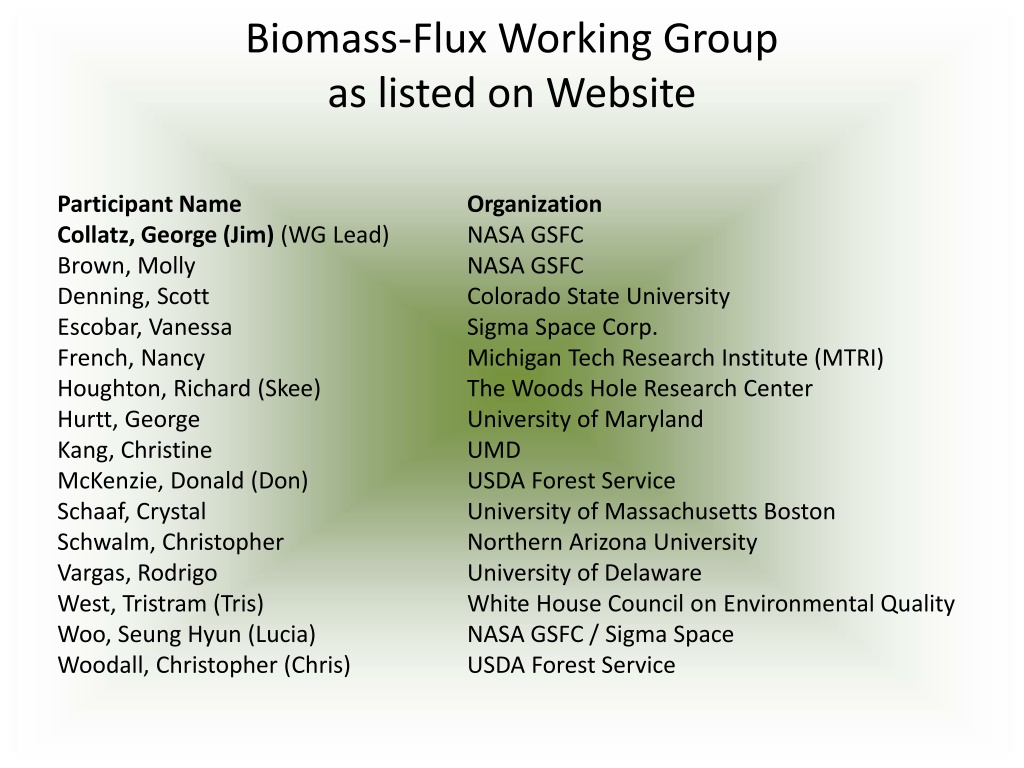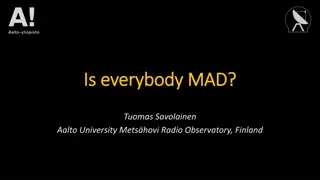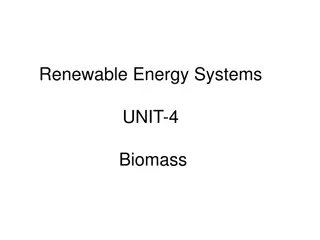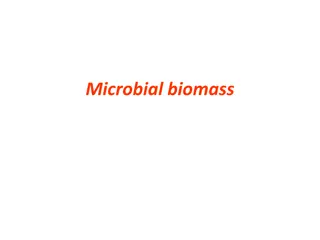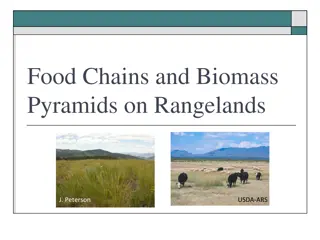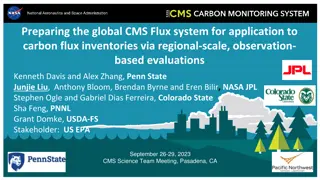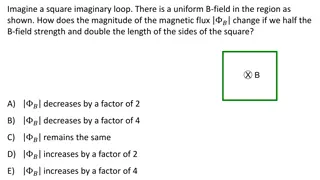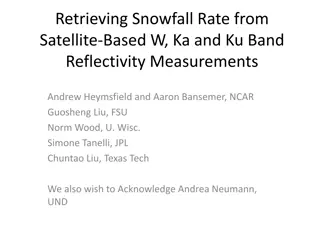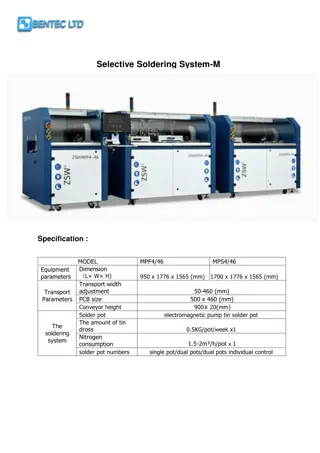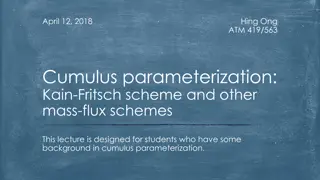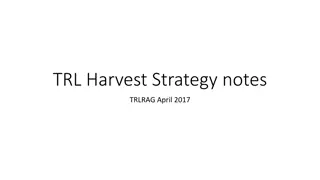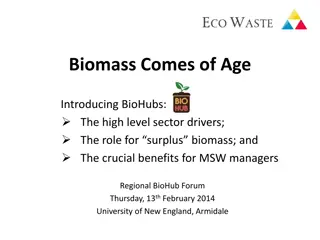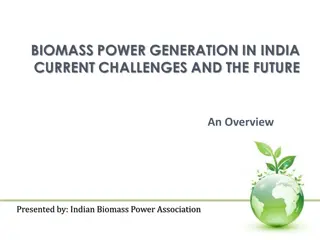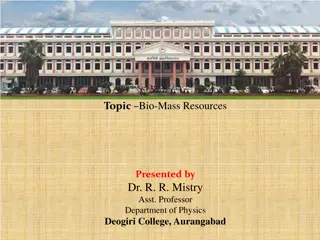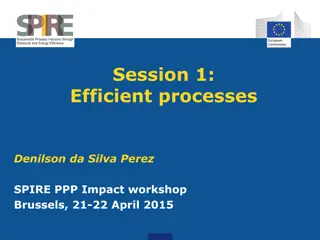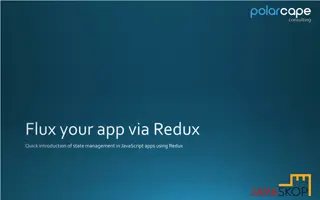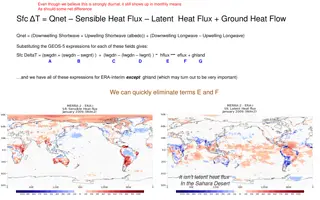Biomass-Flux Working Group Overview
The Biomass-Flux Working Group, a collaboration involving various organizations like NASA and universities, aims to integrate land-atmosphere carbon fluxes and biomass changes to enhance estimations and understanding. By identifying overlapping projects, encouraging cross-comparisons, and reconciling measurements with models, the group seeks to improve carbon monitoring and management for greenhouse gas emissions. Specific themes include biomass monitoring, flux analysis, and their interrelationships, all contributing to a comprehensive approach to understanding carbon dynamics in different ecosystems.
Uploaded on Sep 23, 2024 | 0 Views
Download Presentation

Please find below an Image/Link to download the presentation.
The content on the website is provided AS IS for your information and personal use only. It may not be sold, licensed, or shared on other websites without obtaining consent from the author.If you encounter any issues during the download, it is possible that the publisher has removed the file from their server.
You are allowed to download the files provided on this website for personal or commercial use, subject to the condition that they are used lawfully. All files are the property of their respective owners.
The content on the website is provided AS IS for your information and personal use only. It may not be sold, licensed, or shared on other websites without obtaining consent from the author.
E N D
Presentation Transcript
Biomass-Flux Working Group as listed on Website Participant Name Collatz, George (Jim) (WG Lead) Brown, Molly Denning, Scott Escobar, Vanessa French, Nancy Houghton, Richard (Skee) Hurtt, George Kang, Christine McKenzie, Donald (Don) Schaaf, Crystal Schwalm, Christopher Vargas, Rodrigo West, Tristram (Tris) Woo, Seung Hyun (Lucia) Woodall, Christopher (Chris) Organization NASA GSFC NASA GSFC Colorado State University Sigma Space Corp. Michigan Tech Research Institute (MTRI) The Woods Hole Research Center University of Maryland UMD USDA Forest Service University of Massachusetts Boston Northern Arizona University University of Delaware White House Council on Environmental Quality NASA GSFC / Sigma Space USDA Forest Service
Biomass-Flux Working Group Original draft with my edits The Biomass-Flux working group seeks to integrate land-atmosphere carbon fluxes, biomass, and changes in biomass across CMS to improve estimation of all three. The working group will: (1) query and identify domains in space and time for which various relevant projects overlap; (2) identify and encourage projects to cross-compare flux and biomass products (3) track and summarize results and outcomes of comparisons. The ultimate goal would be to reconcile measurements of biomass and biomass change with process model biomass/fluxes and atmospheric CO2 variability across NASA CMS projects working group topic seems to be a specific, detailed subset within the scopes of the algorithm assessment/intercomparison, system framework, MRV, and atmospheric validation working groups
Biomass-Flux Working Group Relevant CMS Themes CMS Biomass: monitor, manage biomass for greenhouse gas emissions Products: Static Biomass estimates at local to global scales CMS Flux: monitor and diagnose greenhouse gas variability Products: - Biomass, component fluxes (fire, deforestation, harvest) -bottom up process models (diagnostic and dynamic) -atmospheric inversions and data assimilation estimates of sources and sinks derived from atmospheric measurements -relationship between above ground biomass change and atmospheric CO2 (end-to-end) -how do biomass measurements constrain flux estimations? -how do flux estimations constrain biomass measurements?
ATMOSHERIC CO2* Not Local NPP* Fire* RH O Removals BM* Products Mortality* Detritus At steady state: CBM = - Catm Catm =- NPP*+ RH + Fire* + Prodout (Flux focus) CBM = NPP* Fire* Mort* - Removals* (Biomass focus) DCatm DCBM NPP-F-M -R =-NPP+RH +F+O But not over shorter periods of time and locally, also true for component fluxes *potentially informed from Remote Sensing Data
Dynamics of Biomass and Flux Neutral over decades to centuries Harvest & Fire Mortality + - AGE (decades to centuries) Biomass Harvest (remove and emitted elsewhere later) Fire (emitted locally and immediately) +mortality (emitted slowly) Net Flux Long term atmospheric CO2 sinks Growth Enhancement Afforestation long term atmospheric CO2 source Deforestation, Degradation
Relationship between Biomass change and Net Flux at local scales DCAGB NEE HF, Urbanski et al., 2007 Net Flux sink= 2.5 MgC/ha/yr AGB = 1.3 MgC/ha/yr UMBS, Gough et al., 2008 Net Flux sink = 1.6 MgC/ha/yr AGB = 2.2MgC/ha/yr
EXAMPLE of using biomass measurements to constrain flux models: Static Biomass estimates to constrain flux models: Biomass is a function of NPP, allocation, mortality, harvest, fuel loads. A weak constraint on modeled fluxes
Landsat VCT Another EXAMPLE: Static Biomass + disturbance history to Parameterize flux models Williams et al., 2012, 2014
Strategy for linking Biomass products with Flux Products Working Group membership should include projects willing to contribute products that are useful for reconciling BM, fluxes, and atmospheric CO2 variability. Group would define products at useful resolutions, formats and establish working collaborations Issues to be resolved: Problem of scale: at what spatial resolutions can biomass change estimates be related to atmospheric CO2 variability? How to verify/validate modeled fluxes indirect model testing to support confidence in model predictions (local to global) direct measurement of fluxes (eddy covariance, tall towers for regional fluxes) net flux estimations using atmospheric CO2 observations and transport models (regional to global) Should scope be expanded to consider CH4, other biomass and detrital pools? NOTE OVERLAP with other Working Groups: Algorithm Assessment/Intercomparisons System Framework Atmospheric Validation MRV
